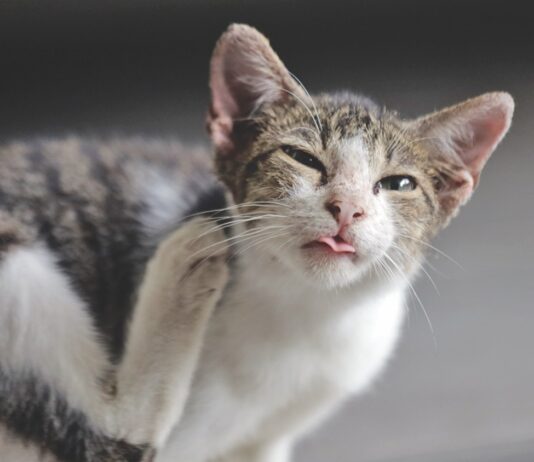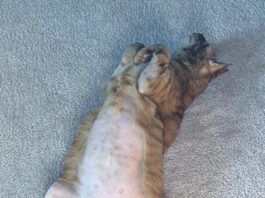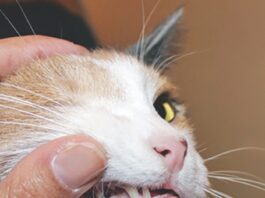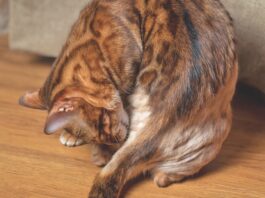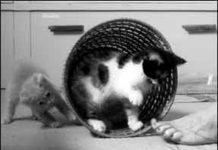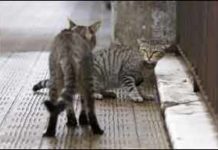Ask Elizabeth: May 2012
I’m hoping that you can help me solve a very frustrating problem. My cat Jessica is a six-year-old Siamese. Her skin has become very dry and flakey, and I think it must be very itchy. She’s constantly scratching at herself, sometimes so roughly that little clumps of her coat fall out. I haven’t taken her to see a veterinarian yet, but a neighbor told me that I should be giving Jessica omega-3 supplements. But omega-3 comes from fish oil, and I think that Jessica is allergic to fish, so I’m afraid to do that. Are there any other sources of omega-3? What other ingredients in her food could be making her so uncomfortable?
Deworming: A Must for Kittens
Few things in the life of a cat owner are sweeter than the sight of a newborn kitten, weighing just a few ounces, its eyes tightly shut, nursing contentedly at its mothers nipple. A healthy kitten will nurse every 20 minutes or so, typically for about eight weeks, during which time its mothers milk will fulfill all of the little animals nutritional needs
Feline Acne: All Cats Are At Risk
Despite its typical durability, a cat’s skin is subject to a wide array of disorders. Most of these conditions, in themselves, are of minor consequence and readily treatable. But all of them merit examination by a veterinarian, since they can signal the presence of a serious infection or other potentially life threatening systemic health problem. Among the various feline skin conditions that might be overlooked — or ignored — by an owner is acne. This disorder, which is characterized by the emergence of tiny black eruptions (blackheads) on a cat’s chin and lips, is a condition that can afflict both male and female cats of all ages and breeds.
Are You Allergic to Your Cat?
If you are allergic to your cat, don’t despair. You are actually far from alone — but luckily, there are increasingly effective methods for dealing with allergies. Believe it or not, at least one in three cat owners has allergies to feline friends. For some, the allergic reaction is limited to itchy, watery eyes. Others may develop asthma or other serious breathing problems. The major culprit behind human allergic reactions to cats originates from cat skin, according to David Rosenstreich, MD, Chief of the Division of Allergy and Immunology at the Albert Einstein College of Medicine and Montefiore Medical Center, Bronx, NY.
Ask Elizabeth: November 2011
Dear Elizabeth: Our seven-year-old female cat Queenie is a spayed, well-behaved Siamese who is never allowed outside. However, there are several free-roaming outdoor cats in the neighborhood, and they have become a real nuisance. About six months ago, my husband and I started smelling evidence that the front of our house and our doors were being scent-marked. The odor of urine is quite noticeable and unpleasant for us and also seems to agitate Queenie. We’ve thought about putting some sort of repellent outside, but we don’t want to use anything that could harm these neighborhood cats or wildlife. Do you have any recommendations? What can we do to stop — or at least discourage — these cats from scent-marking our house?
Ringworm: Very Contagious
Feline dermatophytosis, commonly referred to as ringworm, is a fungal infection that is frequently observed in cats. The condition occurs worldwide, most commonly in warm, humid climates that are hospitable to the peculiar type of fungus that causes it. In the U.S., the disorder is especially problematic year-round in the deep South, says William Miller, VMD, a professor of dermatology at Cornell University’s College of Veterinary Medicine, and its prevalence can rise markedly in cooler areas of the nation with the arrival of hot and muggy summer weather. The clinical signs of ringworm include areas of hair loss, broken and stubbly hair, patches of scaling, crusty or inflamed skin and alterations in hair color.
Short Takes: August 2011
During the second World Conference on Veterinary Education in Lyons, France, an emphasis was placed on animal welfare and the background on the topic that graduating veterinarians need to achieve regardless of their location and training. “Vets can have a direct impact on the attitudes and behaviors of the general public towards animals as advisers to owners as well as to governments and corporations,” explained Ruth De Vere, head of education at the World Society for the Protection of Animals International (WSPA). “After this conference, where the world’s veterinary elite came together globally, I am hopeful that animal welfare will become an integral part of veterinary training.”
Sensitive Skin and Diet: A Challenge
Nothing can be more frustrating for a cat owner - and annoying to a cat - than skin disorders. Nutritional deficiencies or food hypersensitivity; parasites; fungal, viral and bacterial infections; and environmental allergens can cause problems that range from dry, brittle hair and coat to baldness and open wounds. "Most skin diseases are simple and straightforward," says William Miller, Jr., VMD, professor of dermatology at Cornell Universitys College of Veterinary Medicine, "and common problems such as flea bite allergies, abscesses and ear mites are easily recognized, treated and resolved."
How to Implement Flea Control
Fleas are parasites that suck blood for their food, leaving small lesions that are similar to those of mosquito bites. "They are more than a skin problem," cautions Williams Miller, Jr., VMD, professor of clinical science at Cornells College of Veterinary Medicine. "They can become a serious health problem." Cats are fastidious groomers, so healthy adult cats will keep the number of fleas on their bodies low. "But if there is a significant number of fleas feeding on the animal, they can cause severe anemia," explains Dr. Miller.
Diagnosis: Conjunctivitis
Your cats eyes, like yours, are delicate structures made up of various components -the cornea, pupil, iris, lens, retina and so forth - each of which plays a role in enabling the animals keen vision. While the feline eye is generally sturdy and resistant to injuries and disease, a wide variety of disorders, such as glaucoma and cataracts, can impair a cats vision and even, in some cases, lead to blindness. According to Thomas Kern, DVM, an associate professor of ophthalmology at Cornell Universitys College of Veterinary Medicine, the most common of all feline eye disorders is conjunctivitis, an inflammation of the thin mucous membrane (conjunctiva) that lines the inner surface of the eyelids and coats the outer surface of the eyeball.
Abscesses: Potentially Serious Infection
For several days, your cat has been acting oddly, lolling about the house, uncharacteristically lethargic, off his food and seemingly depressed. Then one evening, while stroking his back to comfort the mysteriously dispirited animal, you notice a smallish but alarming lump just to the side of his tail. Although you touch the lump ever so gently, he reacts with a howl, hisses, leaps from your lap and scurries to a dark corner. The lump you discovered is quite possibly an abscess, and although your touching it caused the poor animal intolerable discomfort, its a good thing that you spotted it.
Tackling Cat Hair and Pet Odor
The best strategy to minimize a pet hair problem in your home is to remove loose hair from your cats coat before it hits the floor. And ironically, shorthaired cats often shed more than longhaired cats. Of course, you cant possibly catch all pet hair before it falls out. So when it does make its inevitable landfall, the following are ways to pick up pet hair as easily and thoroughly as possible. Tackling Upholstery.Vacuuming is the first approach to removing cat hair from upholstery; however, if your vacuum isnt removing enough hair, you can try one of several other approaches.

